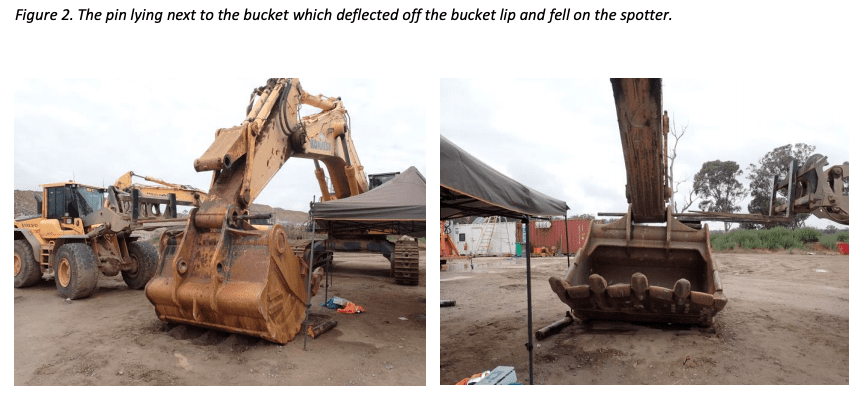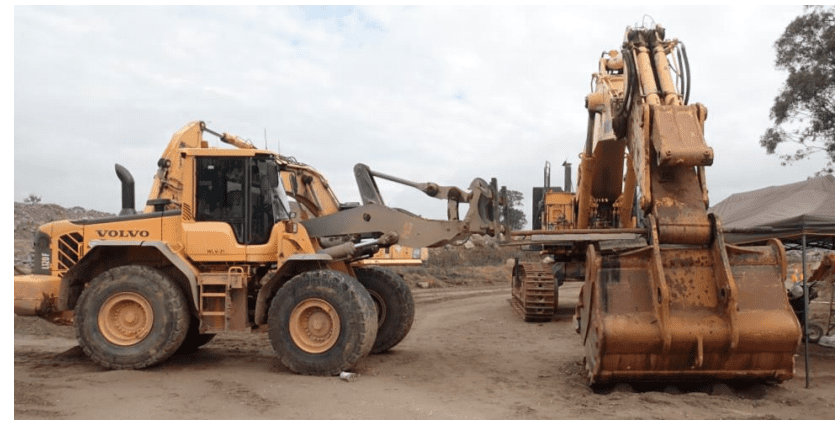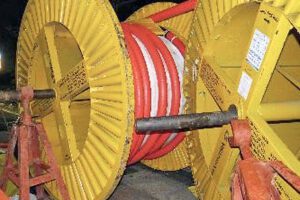The NSW Resources Regulator has released investigation information regarding a worker who was struck by the pin as it was ejected resulting in a compound fracture to his right lower leg at Lynwood Quarry, Marulan NSW.
Worker suffers serious injuries when pinned by continuous miner
Contract maintainer pinned under a cab
On 11 March 2021 at about 5:30am, Divall’s day shift mechanical fitters arrived at the quarry to undertake the task of replacing the bucket on a PC1250 Excavator due to damage to the outer tooth. The bucket is held in position by two pins 140 millimetres diameter, 975 millimetres long and weighing approximately 120-140 kilograms. With the bucket placed on the ground the pins were about 1.9 metres and 2.1 metres from ground height.

The process involved removing the retaining bolts and plate from the end of the pins then pressing the pins from their housing with a drill rod device. The drill rod was welded to a steel box section and slipped onto a fork tine on the wheel loader to provide a horizontal force (refer figure 1). The task was expected to take three to four hours.
The excavator had been placed about 2.5 metres in front of the mobile plant maintenance/hot work concrete slab to allow the wheel loader with fork attachment access to the side of the bucket arm. The ground conditions were soft dirt that had become uneven in places due to machine movements involved in the process of removing the bucket pin.
Toolbox talks, pre-start, Take-5 and Safe Work Method Statement reviews were conducted at 6am, then the retaining bolts for both pins were removed. The first (crowd) pin was removed with ease.
At about 7am the fitters attempted to remove the second (bucket) pin. They employed several different methods to remove the bucket pin, including; a rock hammer attached to another excavator; a hydraulic jack; heating the bushes and cooling the pin; oxy-lancing a bush and sledgehammers, all without success. By 5pm, the fitters had managed to move the pin about 75 millimetres. The job was then put on hold by the fitters until the next day, with one fitter placing his lockout lock on the excavator and speaking to the Divall’s supervisor (the supervisor). The fitters left the site.
Later in the shift, the supervisor decided to have another attempt at the pin removal with the assistance of two workers. At about 6pm two attempts were made using the wheel loader (operated by the supervisor) to remove the bucket pin by pushing the drill rod through the pin holes. Verbal communication and hand signals were used between the machine operators and a worker on the ground designated as a spotter, including the use of radio communication between the wheel loader and excavator.
Following the second attempt, the pin was still stuck, the wheel loader reversed, and the spotter stepped towards the excavator bucket (a witness observed this to be towards the rear of the bucket to view the position of the pins and was out of the line of sight of wheel loader operator/supervisor). Not seeing the spotter, the supervisor drove the loader forward, again hitting the pin. The pin was ejected,m deflecting off the bucket lip. It glanced at the spotter’s shoulder knocking him over and landing on his right leg, causing a compound fracture of his right tibia. The supervisor administered first aid to the worker and contacted emergency personnel and an ambulance.
The investigation is ongoing to determine the causal factors involved in this incident. Arising from the initial investigation, it is recommended mine operators ensure that:
- where a task cannot proceed as planned, ad hoc changes to procedures are avoided. Any changes in procedures should be subject to risk assessment and communicated to all workers affected by the change
- exclusion zones which provide for falling components should be identified, demarcated and managed to ensure workers are not exposed to falling components/equipment. There must be positive communication between all workers involved when any worker enters an exclusion zone
- there is appropriate supervision and monitoring of contractor’s activities on the mine by the mine.
Read more Mining Safety New














Add Comment